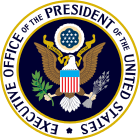Office of National Drug Control Policy
The Office of National Drug Control Policy is a component of the Executive Office of the President of the United States.
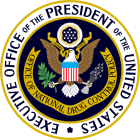 | |
| Agency overview | |
|---|---|
| Formed | October 27, 1989 |
| Headquarters | Washington, D.C., U.S. |
| Annual budget | $379.1 million[1] |
| Agency executive |
|
| Parent agency | Executive Office of the President |
| Website | www |
The Director of National Drug Control Policy, colloquially known as the Drug Czar, heads the office. "Drug Czar" was a term first used in the media by then-Senator Joe Biden in October 1982.[2][3] In addition to running the ONDCP, the director evaluates, coordinates, and oversees both the international and domestic anti-drug efforts of executive branch agencies and ensures that such efforts sustain and complement State and local anti-drug activities. The Director advises the President regarding changes in the organization, management, budgeting, and personnel of federal agencies that affect U.S. anti-drug efforts; and regarding federal agency compliance with their obligations under the National Drug Control Strategy, an annual report required by law. The most recent director is James. W. Carroll, who took over from former director Michael Botticelli. The Fiscal Year 2011 National Drug Control Budget proposed by the Obama Administration would devote significant new resources to the prevention and treatment of drug abuse. These resources are complemented by an aggressive effort to enhance domestic law enforcement, interdiction, and supply control programs. New resources, $340 million, are added to the prevention and treatment of drug use.[4][5]
Programs
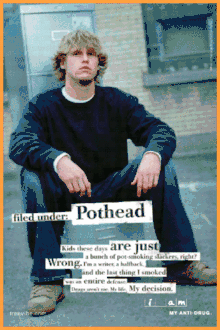
The programs directed by the ONDCP include:
- the High Intensity Drug Trafficking Areas (HIDTA) program
- the National Youth Anti-Drug Media Campaign, a current domestic government propaganda campaign in the US
- the Drug Free Communities Program
- Anti-Doping Activities
- World Anti-Doping Agency (WADA) dues
Congressional issues
Bi-partisan support for Drug Czar
The Anti-Drug Abuse Act of 1988, which created the Office of National Drug Control Policy, was the product of bi-partisan support. It was co-sponsored in the House of Representatives by parties' leaders, Tom Foley and Robert Michel,[6] and it passed by margins of 346–11 and 87–3 in the House and Senate, respectively.[7] Upon signing the law, Ronald Reagan said, "This bill is the product of a bipartisan effort."[8]
Funding
In September 2002, the Senate Appropriations Committee recommended that salaries and expenses at ONDCP be reduced from $26.6 million in fiscal 2006 to $11.5 million in fiscal 2007, to "more closely reflect actual performance." Committee members said they would request funding for a study of ONDCP by the National Academy of Public Administration. They also ordered a Government Accountability Office study on the distribution of grants. Plus, they directed the Director to provide quarterly updates on travel expenditures, staffing levels and plans for future hirings.[9]
In 2011, the ONDCP requested funding for 98 full-time employees, 64 (65.31%) of whom would be paid at either GS-15, GS-14, or SES pay grades, or more than $105,211.00 yearly, being adjusted for Washington, D.C. cost of living expenses.[10]
High-Intensity Drug Trafficking Program
In 2005, the Bush Administration proposed transferring the $225 million High-Intensity Drug Trafficking Program from ONDCP to the Department of Justice. The program gives additional money to communities with chronic illicit drug sales. According to the Washington Post, "Many lawmakers oppose the transfer for fear the program would become less of a priority."[9]
Anti-legalization Policy
By law, the drug czar must oppose any attempt to legalize the use (in any form) of illicit drugs.[11] According to the "Office of National Drug Control Policy Reauthorization Act of 1998"[12] the director of the ONDCP
(12) shall ensure that no Federal funds appropriated to the Office of National Drug Control Policy shall be expended for any study or contract relating to the legalization (for a medical use or any other use) of a substance listed in schedule I of section 202 of the Controlled Substances Act (21 U.S.C. 812) and take such actions as necessary to oppose any attempt to legalize the use of a substance (in any form) that –
1. is listed in schedule I of section 202 of the Controlled Substances Act (21 U.S.C. 812); and
2. has not been approved for use for medical purposes by the Food and Drug Administration;
The Government Accountability Office has found that this law authorizes the ONDCP to disseminate information in order to oppose legalization:[13]
Finally, apart from considerations of whether any particular law has been violated, you have asked whether the Deputy Director's letter disseminated misleading information in connection with statements relating to the debate over legalization of marijuana. Clearly, the Deputy Director's statements reflect one perspective regarding marijuana – a perspective that is disputed by others with different viewpoints. However, ONDCP is specifically charged with the responsibility for "taking such actions as necessary to oppose any attempt to legalize the use" of certain controlled substances such as marijuana – a responsibility which logically could include the making of advocacy statements in opposition to legalization efforts. The Deputy Director's statements about marijuana are thus within the statutory role assigned to ONDCP. Given this role, we do not see a need to examine the accuracy of the Deputy Director's individual statements in detail.
Effectiveness of ONDCP
Extent of drug use in the U.S.
In September 2006, the office reported that the 2005 survey of 67,500 people found that 8.1 percent reported using an illicit drug in the 30 days prior to being asked about their drug use, which equates to 19.7 million people nationwide (age 12 and older). The percentage was up slightly compared to 2004. Youth drug use declined for the third year in a row.[14] While the ONDCP measures their efficacy against prior use statistics within the U.S., they do not publicize how these statistics compare against other countries at the time in their communications to the press. In 2008, ONDCP reported that actual youth drug use, as measured as the percent reporting past month use, has declined from 19.4% to 14.8% among middle and high school students between 2001 and 2007.[15]
Anti-marijuana advertising
In August 2001, the office told a Congressional committee that its National Youth Anti-Drug Media Campaign "has been the most visible symbol of the federal government's commitment to drug prevention," and that the office was "investing $7 million a year in performance measurement to determine the effectiveness" of the campaign. The statement by said "We believe there is a strong body of evidence that indicates the campaign is working, as planned, to change drug attitudes, intentions and use."[16]
In 2002, according to a multiyear study by the research firm hired by the office, teenagers exposed to federal anti-drug ads were no less likely to use drugs for having viewed them, and some young girls said they were even more likely to give drugs a try. Walters blamed poor ads that weren't resonating with teenagers. Walters promised in Senate testimony in 2002 that he would show results within a year or admit failure, and Congress agreed to extend the campaign through 2003 while cutting funding for the ads from $170 million in 2002 to $150 million in 2003. An entirely new advertising campaign was created.[17]
In February 2005, a research company hired by the office and the National Institute on Drug Abuse reported that the government's ad campaign aimed at dissuading teens from using marijuana, a campaign that cost $1.4 billion between 1998 and 2006, did not work: "greater exposure to the campaign was associated with weaker anti-drug norms and increases in the perceptions that others use marijuana." The research company was paid $42.7 million for the five-year study. After the February 2005 report was received, the office continued the ad campaign, spending $220 million on the anti-marijuana ads in fiscal years 2005 and 2006.[18]
Other
According to the University of Michigan's annual Monitoring the Future report, the number of young people using drugs in the U.S. declined by 7 percent between 2001 and 2006,[19] though there is no evidence to suggest that government anti-drug programs that were started at the turn of the millennium helped cause this drop.
While cocaine production in Colombia initially decreased with the onset of Plan Colombia, the United Nations declared that in 2005, despite record levels of eradication by the U.S., coca production increased to about 330 square miles (850 km2).[20]
Controversies
Paying for anti-drug messages in television shows
In the spring of 1998, the ONDCP began offering additional advertising dollars to networks that embedded anti-drug messages in their programming. They developed an accounting system to decide which network shows would be valued and for how much. Receiving advance copies of scripts, they assigned financial value to each show's anti-drug message. Then they would suggest ways that the networks could increase the payments they would get. The WB network's senior vice president for broadcast standards Rick Mater admitted, "The White House did view scripts. They did sign off on them – they read scripts, yes."[21]
Running the campaign for the ONDCP was Alan Levitt, who estimated that between 1998 and 2000 the networks received nearly $25 million in benefits.[21]
One example was with Warner Brothers' show, Smart Guy. The original script portrayed two young people using drugs at a party. Originally depicted as cool and popular, after input from the drug office, "We showed that they were losers and put them [hidden away to indulge in shamed secrecy] in a utility room. That was not in the original script."[21]
Other shows including ER, Beverly Hills, 90210, Chicago Hope, The Drew Carey Show and 7th Heaven also put anti-drug messages into their stories.[21]
In 2000, the Federal Communications Commission, in response to a complaint by the National Organization for the Reform of Marijuana Laws, sent inquiries to five major television networks about these practices.[22] The House Committee on Government Reform's Subcommittee on Criminal Justice, Drug Policy and Human Resources held hearings on the matter on July 11, 2000.[23] In December of that year, the FCC ruled that the networks should have identified the Office of National Drug Control Policy as the sponsor of the television programs.[24][25]
State and local decriminalization ballot measures
In December 2002, the Marijuana Policy Project, filed a complaint with the Nevada Secretary of State accusing the Drug Czar John Walters of illegally campaigning against its 2002 ballot initiative to decriminalize possession of up to 3 ounces of cannabis in that state. Specifically, MPP argued that Nevada campaign finance laws required the Drug Czar to reveal how much taxpayer money he had spent to defeat the initiative. In April 2003, the Nevada Attorney General concluded that the Drug Czar was not required to comply with Nevada's campaign finance laws. MPP filed a writ of mandamus as an appeal of the decision. The Nevada Supreme Court issued an order declaring that MPP had "set forth issues of arguable merit" in its writ; however, on August 18, 2004, the Court declared that it was "not satisfied that [the] court's intervention by way of extraordinary relief is warranted".[26]
A February 24, 2005 MPP press release announced that the group had filed similar complaints in Montana, Oregon, and Alaska, accusing the Drug Czar of failing to make legally required campaign expense disclosures:[27]
- On October 5, 2004, the drug czar traveled to Oregon for the purpose of opposing Measure 33, a ballot measure designed to expand the state's medical marijuana program. On October 6, ONDCP Deputy Director Scott Burns traveled to Montana to campaign against Initiative 148, the medical marijuana measure passed by voters in November. And on October 13 and 14, Burns traveled to Alaska to oppose Measure 2, a measure to allow the state to tax and regulate the sale of marijuana. All of these trips were widely reported in the local press as being campaign stops in opposition to the reform initiatives.
Use of video news releases
In 2005, the Government Accountability Office found that the ONDCP had violated domestic propaganda and publicity prohibitions by preparing prepackaged news stories that did not disclose to television viewers that the government had produced them, had illegally spent appropriations to develop, produce and distribute the covert propaganda but use of the term "Drug Czar" in the "Video News Releases" had not constituted unlawful self-aggrandizement.[28]
ONDCP supporters such as Representatives Tom Davis and Mark Edward Souder have dismissed such criticism on the grounds that the ONDCP is expressly authorized by law to conduct anti-drug media campaigns.[29] According to Susan A. Poling, managing associate general counsel at the GAO, "What is objectionable about these is the fact the viewer has no idea their tax dollars are being used to write and produce this video segment.".[29]
2017 reported shutdown
As early as February 2017, The New York Times had reported that the Trump administration was considering eliminating the office, and other programs responsible for a total of $2.5 billion of domestic spending.[30] In May, the office's website was blanked and Politico and The Washington Post both reported that the office was about to be drastically defunded.[31][32] Later the office's website was unblanked.
List of Directors
The title of Director, as well as the office, was created by the Anti-Drug Abuse Act of 1988. The position had cabinet-level status from 1993 to 2009.
| # | Portrait | Name | Term | President |
|---|---|---|---|---|
| 1 |  |
Bill Bennett | March 13, 1989 – December 13, 1990 | George H. W. Bush |
| 2 | .jpg) |
Bob Martinez | March 28, 1991 – January 20, 1993 | |
| – | 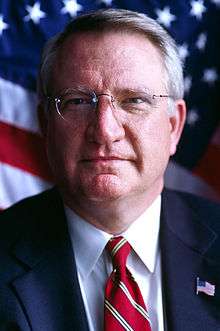 |
John Walters Acting |
January 20, 1993 – July 19, 1993 | Bill Clinton |
| 3 | 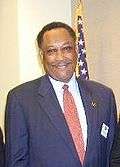 |
Lee Brown | July 19, 1993 – January 1996 | |
| 4 | 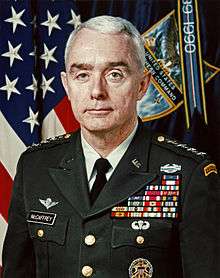 |
Barry McCaffrey | February 29, 1996 – January 20, 2001 | |
| – |  |
Ed Jurith Acting |
January 20, 2001 – December 7, 2001 | George W. Bush |
| 5 |  |
John Walters | December 7, 2001 – January 20, 2009 | |
| – |  |
Ed Jurith Acting |
January 20, 2009 – May 7, 2009 | Barack Obama |
| 6 | 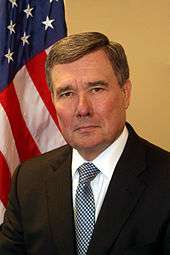 |
Gil Kerlikowske | May 7, 2009 – March 6, 2014 | |
| 7 | 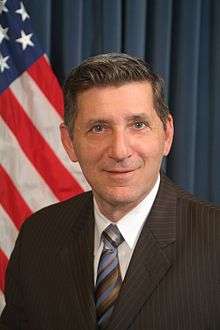 |
Michael Botticelli Acting: 2014–2015 |
March 6, 2014 – January 20, 2017 | |
| – |  |
Kemp Chester Acting |
January 20, 2017 – March 27, 2017 | Donald Trump |
| – |  |
Rich Baum Acting |
March 28, 2017 – February 9, 2018 | |
| 8 | .jpg) |
Jim Carroll
Acting: 2018–2019 |
February 9, 2018 – present January 3, 2019 – present |
Legislation and executive orders
- 1988 Anti-Drug Abuse Act
- 1993 Executive Order 12880
- 1994 Violent Crime Control and Law Enforcement Act
- 1996 Executive Order 12992
- 1996 Executive Order 13023
- 1997 Drug-Free Communities Act
- 1998 Media Campaign Act
- 1998 ONDCP Reauthorization Act
- 2000 Executive Order 13165
- Title 21 of the Code of Federal Regulations
- 2018 Reauthorization
See also
- Drug Enforcement Administration
- Drug policy of the United States
- Gary Webb
- Legal issues of cannabis
- Medical cannabis
- National Institute on Drug Abuse
- Opioid and Drug Abuse Commission
- War on Drugs
References
- "National Drug Control Budget" (PDF). whitehouse.gov. Office of National Drug Control Policy. Retrieved 21 December 2018.
- Maintland, Leslie. (October 9, 1982) New York Times U.S. plans a new drive on narcotics. Section: 1; Page 18. (noting, "But Senator Joseph R. Biden Jr., the Delaware Democrat who is a strong advocate of antinarcotics efforts, said today that he thought no program could work without a Cabinet-level "drug czar" in charge to coordinate the work of various agencies.")
- "Joe Biden Coined The Term "Drug Czar", Wrote Laws Banning Drug Paraphenilia". Archived from the original on 2008-09-23. Retrieved 2009-09-02.
- FY 2011 Drug Control Program Highlights
- Administration's FY 2011 Budget Proposal Demonstrates Balanced Approach to Drug Control February 1, 2010
- Bill History for H.R. 5210, the Anti-Drug Abuse Act of 1988.
- Major Congressional Actions for H.R. 5210, the Anti-Drug Abuse Act of 1988.
- President Reagan's signing statement
- Kevin Freking, "Panel Advises Cutting Salaries at Agency", Washington Post, September 12, 2006
- Office of National Drug Control Policy Fiscal Year 2012 Appropriations Request (PDF file)
- The Drug Czar is required by law to lie
- Title VII Office of National Drug Control Policy Reauthorization Act of 1998
- Application of Anti-Lobbying Laws to the Office of National Drug Control Policy's Open Letter to State Level Prosecutors, B-301022, March 10, 2004
- Kevin Freking, "Drug Use Up for Boomers, Down for Teens", Washington Post, September 7, 2006
- Office of National Drug Control Policy Executive Office of the President: CURRENT STATE OF DRUG POLICY: SUCCESSES AND CHALLENGES, March 2008
- "National Youth Anti-Drug Media Campaign: How to Ensure the Program Operates Efficiently and Effectively", Testimony to Congress, August 1, 2001
- Shawn Zeller, "Ads, Drugs & Money" Archived 2007-03-15 at the Wayback Machine, Government Executive magazine, September 19, 2003
- Ryan Grim, A White House Drug Deal Gone Bad: Sitting on the Negative Results of a Study of Anti-Marijuana Ads, Slate magazine, September 7, 2006
- "Monitoring the Future" (MTF) survey, December 2006
- "Coca production up despite record eradication" (MSNBC), June 2006
- Prime-time propaganda Archived 2007-01-15 at the Wayback Machine, January 13, 2000, Salon.com
- "FCC Sends Formal Inquiries To Five Television Networks Allegedly Involved In ONDCP Payola Scandal", NORML news bulletin, April 20, 2000
- "House Committee To Hold July 11 Hearing On ONDCP Payola Scandal; Salon.com Writer Who Broke The Story Will Face-Off Against Drug Czar", NORML news bulletin, June 29, 2000
- "FCC Rules In Favor of NORML", NORML News Bulletin, December 28, 2000
- FCC termination of investigation of February 17, 2000 complaint by NORML, letter dated December 20, 2000
- "MPP's first victory in 'War on Drug Czar' campaign is short-lived; Nevada Supreme Court order allows Drug Czar to ignore state campaign finance laws" Archived 2005-03-05 at the Wayback Machine, Marijuana Policy Project
- War On Drug Czar Archived 2005-03-05 at the Wayback Machine
- "Office of National Drug Control Policy—Video News Release". U.S. Government Accountability Office. 2005-01-04. Retrieved 2008-09-06.
- Christopher Lee, "Anti-Drug Office's Videos Defended: Davis Says Ruling That Law Was Violated Is Wrong", Washington Post, February 4, 2005
- Sharon LaFraniere and Alan Rappeport (February 17, 2017), "Popular Domestic Programs Face Ax Under First Trump Budget", The New York TimesCS1 maint: uses authors parameter (link)
- Dan Diamond (May 5, 2017), "Trump budget would effectively kill drug control office", Politico
- Report: White House plans to slash funding for fed Drug Control Policy office, The Washington Post, May 5, 2017, archived from the original on May 6, 2017, retrieved May 7, 2017 – via MassCentral
Further reading
- "ONDCP's Fiscal year 2011 National Drug Control Budget: Are We Still Funding a War on Drugs?", hearing of the Domestic Policy Subcommittee, Committee on Oversight and Government Reform, US House of Representatives (14 April 2010) – chaired by Rep. Dennis Kucinich, testimony from Ethan Nadelmann, director Drug Policy Alliance, and Gil Kerlikowske, director ONDCP
